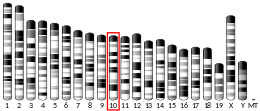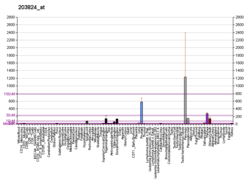TSPAN8
Tetraspanin-8 is a protein that in humans is encoded by the TSPAN8 gene.[5][6]
| TSPAN8 | |||||||||||||||||||||||||
|---|---|---|---|---|---|---|---|---|---|---|---|---|---|---|---|---|---|---|---|---|---|---|---|---|---|
| Identifiers | |||||||||||||||||||||||||
| Aliases | TSPAN8, CO-029, TM4SF3, tetraspanin 8 | ||||||||||||||||||||||||
| External IDs | OMIM: 600769 MGI: 2384918 HomoloGene: 20968 GeneCards: TSPAN8 | ||||||||||||||||||||||||
| |||||||||||||||||||||||||
| |||||||||||||||||||||||||
| |||||||||||||||||||||||||
| |||||||||||||||||||||||||
| Orthologs | |||||||||||||||||||||||||
| Species | Human | Mouse | |||||||||||||||||||||||
| Entrez | |||||||||||||||||||||||||
| Ensembl | |||||||||||||||||||||||||
| UniProt | |||||||||||||||||||||||||
| RefSeq (mRNA) | |||||||||||||||||||||||||
| RefSeq (protein) | |||||||||||||||||||||||||
| Location (UCSC) | Chr 12: 71.13 – 71.44 Mb | Chr 10: 115.82 – 115.85 Mb | |||||||||||||||||||||||
| PubMed search | [3] | [4] | |||||||||||||||||||||||
| Wikidata | |||||||||||||||||||||||||
| |||||||||||||||||||||||||
Function
The protein encoded by this gene is a member of the transmembrane 4 superfamily, also known as the tetraspanin family. Most of these members are cell-surface proteins that are characterized by the presence of four hydrophobic domains. The proteins mediate signal transduction events that play a role in the regulation of cell development, activation, growth and motility. This encoded protein is a cell surface glycoprotein that is known to complex with integrins. This gene is expressed in different carcinomas. The use of alternate polyadenylation sites has been found for this gene.[6]
Clinical significance
Overall survival of ovarian cancer patients was effectively predicted by TSPAN8.[7]
gollark: I mean, my brain only has access to bounded memory and computing time.
gollark: Gibson said "they decide how they wanted to referred to", which seems excessively general since, again, the supreme overlord of all, master of all space and time, destroyer of worlds, devourer of souls/the supreme overlord of all, master of all space and time, destroyer of worlds, devourer of souls/the supreme overlord of all, master of all space and time, destroyer of worlds, devourer of souls's/the supreme overlord of all, master of all space and time, destroyer of worlds, devourer of souls's/the supreme overlord of all, master of all space and time, destroyer of worlds, devourer of souls.
gollark: English is far too complex for sed.
gollark: Not really.
gollark: I'm accepting of people... having genders, but not insisting on specific grammatical constructs because of them.
References
- GRCh38: Ensembl release 89: ENSG00000127324 - Ensembl, May 2017
- GRCm38: Ensembl release 89: ENSMUSG00000034127 - Ensembl, May 2017
- "Human PubMed Reference:". National Center for Biotechnology Information, U.S. National Library of Medicine.
- "Mouse PubMed Reference:". National Center for Biotechnology Information, U.S. National Library of Medicine.
- Szala S, Kasai Y, Steplewski Z, Rodeck U, Koprowski H, Linnenbach AJ (September 1990). "Molecular cloning of cDNA for the human tumor-associated antigen CO-029 and identification of related transmembrane antigens". Proceedings of the National Academy of Sciences of the United States of America. 87 (17): 6833–7. doi:10.1073/pnas.87.17.6833. PMC 54632. PMID 2395876.
- "Entrez Gene: TSPAN8 tetraspanin 8".
- Fekete T, Rásó E, Pete I, Tegze B, Liko I, Munkácsy G, Sipos N, Rigó J, Györffy B (July 2012). "Meta-analysis of gene expression profiles associated with histological classification and survival in 829 ovarian cancer samples" (PDF). International Journal of Cancer. 131 (1): 95–105. doi:10.1002/ijc.26364. PMID 21858809.
Further reading
- Berditchevski F (December 2001). "Complexes of tetraspanins with integrins: more than meets the eye". Journal of Cell Science. 114 (Pt 23): 4143–51. PMID 11739647.
- Maruyama K, Sugano S (January 1994). "Oligo-capping: a simple method to replace the cap structure of eukaryotic mRNAs with oligoribonucleotides". Gene. 138 (1–2): 171–4. doi:10.1016/0378-1119(94)90802-8. PMID 8125298.
- Gwynn B, Eicher EM, Peters LL (July 1996). "Genetic localization of Cd63, a member of the transmembrane 4 superfamily, reveals two distinct loci in the mouse genome". Genomics. 35 (2): 389–91. doi:10.1006/geno.1996.0375. PMID 8661157.
- Suzuki Y, Yoshitomo-Nakagawa K, Maruyama K, Suyama A, Sugano S (October 1997). "Construction and characterization of a full length-enriched and a 5'-end-enriched cDNA library". Gene. 200 (1–2): 149–56. doi:10.1016/S0378-1119(97)00411-3. PMID 9373149.
- Serru V, Le Naour F, Billard M, Azorsa DO, Lanza F, Boucheix C, Rubinstein E (May 1999). "Selective tetraspan-integrin complexes (CD81/alpha4beta1, CD151/alpha3beta1, CD151/alpha6beta1) under conditions disrupting tetraspan interactions". The Biochemical Journal. 340 ( Pt 1) (Pt 1): 103–11. doi:10.1042/0264-6021:3400103. PMC 1220227. PMID 10229664.
- Kanetaka K, Sakamoto M, Yamamoto Y, Yamasaki S, Lanza F, Kanematsu T, Hirohashi S (November 2001). "Overexpression of tetraspanin CO-029 in hepatocellular carcinoma". Journal of Hepatology. 35 (5): 637–42. doi:10.1016/S0168-8278(01)00183-0. PMID 11690710.
- Shackel NA, McGuinness PH, Abbott CA, Gorrell MD, McCaughan GW (September 2003). "Novel differential gene expression in human cirrhosis detected by suppression subtractive hybridization". Hepatology. 38 (3): 577–88. doi:10.1053/jhep.2003.50376. PMID 12939584.
- Kuhn S, Koch M, Nübel T, Ladwein M, Antolovic D, Klingbeil P, Hildebrand D, Moldenhauer G, Langbein L, Franke WW, Weitz J, Zöller M (June 2007). "A complex of EpCAM, claudin-7, CD44 variant isoforms, and tetraspanins promotes colorectal cancer progression". Molecular Cancer Research. 5 (6): 553–67. doi:10.1158/1541-7786.MCR-06-0384. PMID 17579117.
This article is issued from Wikipedia. The text is licensed under Creative Commons - Attribution - Sharealike. Additional terms may apply for the media files.




